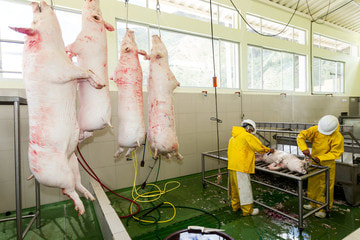chemical free - PATENTED TECHNOLOGY
Ozone is the perfect solution for the Food Processing Industry regarding plant cleaning, disinfecting, and sanitizing. The following data and images offer clear facts to the benefits of ozone.
No doubt you have seen information about the attributes of ozone being an effective agent of against Listeria, E-Coli, Salmonella, Hepatitis, Cholera, and other bacteria and pathogens. Other articles noted USDA -- FDA acceptance in June 2001; Inherent risks of the traditionally used chlorine chemical gas; and several incidents involving recent Listeria recalls.
No doubt you have seen information about the attributes of ozone being an effective agent of against Listeria, E-Coli, Salmonella, Hepatitis, Cholera, and other bacteria and pathogens. Other articles noted USDA -- FDA acceptance in June 2001; Inherent risks of the traditionally used chlorine chemical gas; and several incidents involving recent Listeria recalls.
The video below uses our system at 2ppm of ozone to effectively clean and sanitize the processing equipment at a Fortune 500 Poultry facility.
OZONE SANITATION TECHNOLOGIES, INC.
What makes Ozone Sanitation Technologies Equipment Superior to Other Systems?
Our equipment incorporates our Patented OST Mixing System, which mixes and separates OVER 97% ozone gas in the water solution. The result is a higher ozone concentration, with much less off gas compared to the other competitors systems. In other words, a faster, safer and more effective application.
Our equipment incorporates our Patented OST Mixing System, which mixes and separates OVER 97% ozone gas in the water solution. The result is a higher ozone concentration, with much less off gas compared to the other competitors systems. In other words, a faster, safer and more effective application.
Ozone is Proven Effective.
"Ozone is the most effective antimicrobial agent known. It kills E-coli 3,125 times faster than chlorine, and it converts into ordinary oxygen after the process, leaving no chemical residuals behind."
Ozone technology offers many advantages, its proponents claim. Its efficiency at ambient temperatures is as great as ultra-hot water. And water treated with ozone can be effectively reused requiring limited filtration. Ozonated water can be used anywhere in a packing or processing plant. "Anywhere you're running water through pipes, you can use low-level ozonated water. You can use higher levels of ozonated water in cleaning off equipment, conveyor belts, hooks, and those sorts of things-in addition to actually coming into contact with a food product.
Companies are also using our Ozone Air Clean Systems. These systems provide low-level ozone which can be used in a gaseous form to help control mold, fungus, bacterial growth and mildew in areas like cold storage and holding rooms.
Ozone destroys pathogens by attacking and oxidizing the cell walls of the organism; the mucous membranes.
It doesn't matter whether they are gram-positive or gram-negative. Whether they are spores, whether they are active, or whether they are amoeba-types (or microorganisms). The pathogens are all comprised of double-carbon bonds to hold the molecular structure together, and any microorganisms exposed to ozone will not just become benign in the water, but instead it will be completely evaporated. That's because ozone will continue to break that molecular chain down until it's nothing but carbon dioxide and water.
"Ozone is the most effective antimicrobial agent known. It kills E-coli 3,125 times faster than chlorine, and it converts into ordinary oxygen after the process, leaving no chemical residuals behind."
Ozone technology offers many advantages, its proponents claim. Its efficiency at ambient temperatures is as great as ultra-hot water. And water treated with ozone can be effectively reused requiring limited filtration. Ozonated water can be used anywhere in a packing or processing plant. "Anywhere you're running water through pipes, you can use low-level ozonated water. You can use higher levels of ozonated water in cleaning off equipment, conveyor belts, hooks, and those sorts of things-in addition to actually coming into contact with a food product.
Companies are also using our Ozone Air Clean Systems. These systems provide low-level ozone which can be used in a gaseous form to help control mold, fungus, bacterial growth and mildew in areas like cold storage and holding rooms.
Ozone destroys pathogens by attacking and oxidizing the cell walls of the organism; the mucous membranes.
It doesn't matter whether they are gram-positive or gram-negative. Whether they are spores, whether they are active, or whether they are amoeba-types (or microorganisms). The pathogens are all comprised of double-carbon bonds to hold the molecular structure together, and any microorganisms exposed to ozone will not just become benign in the water, but instead it will be completely evaporated. That's because ozone will continue to break that molecular chain down until it's nothing but carbon dioxide and water.
THE LEADER IN OZONE AIR, WATER TREATMENT, AND SANITATION APPLICATIONS



